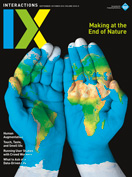Authors:
Loren Terveen, Aaron Quigley
When you think of human-computer interaction conferences, maybe you think first and only of the flagship CHI conference. This past May, over 3,800 people from more than 50 countries attended CHI 2016 in San Jose, California. In 2017, CHI will be held in Denver, Colorado, and in 2018, it will take place in Montreal, Quebec.
But CHI is only one of 23 conferences sponsored by SIGCHI. In this column we—as SIGCHI president and SIGCHI Adjunct Chair for Specialized Conferences—want to tell you a bit about the other 22 conferences, how we support them (and CHI), and some ideas for the future.
Our 22 specialized conferences cover a range of HCI topics and methods and take place throughout the year and around the world. (Browse http://www.sigchi.org/conferences to find out more!) The 2016 SIGCHI conference schedule began in February with the 10th International Conference on Tangible, Embedded, and Embodied Interaction (TEI 2016) in Eindhoven, the Netherlands—and will end in November with the Conference on Supporting Groupwork (GROUP 2016) in Sanibel Island, Florida. Whatever your specialty in the design and study of interactive systems—from children to robots, from TV to interactive spaces, from play to work—you are likely to find a SIGCHI conference that covers it.
What role does SIGCHI play in making these conferences possible? Let's start with ACM: When ACM sponsors a conference, it takes on the associated financial risk and the legal responsibility. But more specifically, when SIGCHI sponsors a conference, we too bear part of the financial risk, so if a conference loses money one year, it doesn't go out of business, and nor does the next year's conference start in the hole. We also provide benefits to conference organizers, including online guidance (www.sigchi.org/conferences/organisingasigchisponsoredorco-sponsoredconference/) as well as reviewing and registration software. We have recently started a SIGCHI Conferences Development Fund and a SIGCHI Student Travel Grant that conferences can draw on to innovate and increase participation. In addition to our 23 sponsored conferences, we also give "in cooperation" status to another 30 conferences annually.
Maybe one of our sponsored conferences is your "home." Maybe you attend it regularly, showcase your work there, meet old friends and make new ones. But quick—how many of the other conferences can you name? If you're like most of us, not many. Is this a problem? Maybe you or your students or your colleagues are missing out on that next great problem, that new technology, that new domain, or that new method that will magnify the impact of your work or expand the horizons of your thinking. We take this as an opportunity: How do we better share knowledge and foster collaboration among SIGCHI conferences?
We put it this way: Can we foster the creation of a family of conferences? The only path to this goal is to gauge interest and gather ideas from the conferences themselves and then play a facilitating role. We thus surveyed the steering committees of each of the 22 specialized conferences to explore how they might like to connect with each other and with CHI. The results showed some areas of interest. We have already acted on one of them—creating a visible presence for each specialized conference by designing 22 large banners that were displayed at CHI 2016 and will be displayed at subsequent CHI conferences. We see them as a means of raising awareness of the specialized conferences and creating opportunities for new people to meet core members of each of these communities. If you attended CHI 2016, we welcome your feedback on the banners.
Survey respondents also supported bringing videos, posters, and demos from specialized conferences to CHI. However, we were reminded that the CHI conference already is big and can feel overwhelming, so how to implement this idea is not yet clear. We are continuing to investigate how CHI might further serve as a meeting point for the SIGCHI family of conferences; again, we welcome your input.
How do we better share knowledge and foster collaboration among SIGCHI conferences?
The survey found less support for mechanisms for specialized conferences to connect with each other, such as sharing videos, demos, and invited talks, or even colocation. Respondents had concerns about logistics, topic compatibility, and timing. Thus, we are going back to the drawing board to brainstorm other ways to improve crossconference synergy without damaging individual conferences' identity and sense of community, or burdening their organizers. We think fostering the connections is worthwhile because of the opportunities for conferences to learn from each other—for example, to share recent innovations such as live-streaming talks and telepresence—as well as to increase learning and enhance our members' experience.
How would you create a SIGCHI family of conferences? You can email Loren at [email protected] or Aaron at [email protected] (for a list of all SIGCHI officers: http://www.sigchi.org/people/officers/index_html#EC). We encourage you to share your ideas for improving the SIGCHI conference experience!
Loren Terveen, President, ACM SIGCHI, [email protected]
Aaron Quigley, Adjunct Chair for Specialized Conferences, ACM SIGCHI, [email protected]
Copyright held by authors
The Digital Library is published by the Association for Computing Machinery. Copyright © 2016 ACM, Inc.









Post Comment
No Comments Found